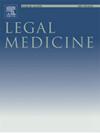A nationwide forensic case-series of femicides in Italy – Part 2: Clues to its epidemiology, prediction and prevention
IF 1.4
4区 医学
Q3 MEDICINE, LEGAL
引用次数: 0
Abstract
Femicides are grievous, but little is known about risk factors and preventive measures. We present the results of a study conducted across 27 Italian Forensic Institutes. We analyzed 1,238 cases of female homicide and, adopting the definition of femicide as the murder due to the failure to recognize women’s right to self-determination, we identified 410 cases as femicides and 395 as non-femicides Current partners were identified as aggressors in a much larger proportion of femicide cases (241 femicides vs. 145 non-femicides; odds ratio (OR) of femicide 2.46, 95 % CI 1.85–3.27), such association being more pronounced for ex-partners (102 vs. 11; OR 11.56, 95 % CI 6.10–21.92). Sharp weapons showed a higher frequency in femicides (168 vs. 140; OR 1.26, 95 % CI 0.95–1.68). Femicides were more often associated with bodies found in vehicles (31 vs. 9; OR 3.50, 95 % CI 1.64–7.45) and outdoor (68 vs. 43; OR 1.62, 95 % CI 1.08–2.45).
There was an indication of femicides being more frequently associated with overkilling (87/323 vs. 71/324; OR 1.24, 95 % CI 0.88–1.76) and even more with lesions located in erogenous zones (94/316 vs. 70/325; OR 1.38, 95 % CI: 0.97–1.95). However, the strongest (though statistically imprecise) association emerged for overkilling in erogenous zones (12/398 vs. 6/389; OR 1.95, 95 % CI: 0.72–5.25). The number of lesions showed a nonlinear association with femicide likelihood.
These findings offer forensic indicators that could contribute in predicting and potentially prevent femicide occurrence in a Western population such as the Italian one.
意大利全国范围的法医案件-第2部分:其流行病学,预测和预防的线索。
杀害妇女是令人痛心的,但人们对危险因素和预防措施知之甚少。我们提出了在27个意大利法医研究所进行的一项研究的结果。我们分析了1238起女性杀人案,并将杀害女性定义为未承认妇女自决权的谋杀,我们将410起案件确定为杀害女性,395起案件确定为非杀害女性。在杀害女性的案件中,目前的伴侣被确定为侵犯者的比例要大得多(杀害女性的241人对非杀害女性的145人;杀害女性的比值比(OR)为2.46,95% CI为1.85-3.27),这种关联在前伴侣中更为明显(102对11;(11.56, 95% ci 6.10-21.92)。锐利武器在杀害女性中的使用频率更高(168比140;OR 1.26, 95% CI 0.95-1.68)。杀女性者通常与在车辆(31对9;OR 3.50, 95%可信区间1.64-7.45)和户外(68对43;OR 1.62, 95%可信区间1.08-2.45)中发现的尸体有关。有迹象表明,杀女性剂更频繁地与过度杀戮相关(87/323 vs. 71/324; OR 1.24, 95% CI 0.88-1.76),甚至与位于性敏感区的病变相关(94/316 vs. 70/325; OR 1.38, 95% CI: 0.97-1.95)。然而,最强烈的关联(尽管统计上不精确)出现在性敏感区的过度杀戮(12/398比6/389;OR 1.95, 95% CI: 0.72-5.25)。病变的数量与杀害女性的可能性呈非线性关系。这些发现提供了法医指标,可以有助于预测和潜在地防止杀害妇女事件在西方人口中发生,如意大利人。
本文章由计算机程序翻译,如有差异,请以英文原文为准。
求助全文
约1分钟内获得全文
求助全文
来源期刊

Legal Medicine
Nursing-Issues, Ethics and Legal Aspects
CiteScore
2.80
自引率
6.70%
发文量
119
审稿时长
7.9 weeks
期刊介绍:
Legal Medicine provides an international forum for the publication of original articles, reviews and correspondence on subjects that cover practical and theoretical areas of interest relating to the wide range of legal medicine.
Subjects covered include forensic pathology, toxicology, odontology, anthropology, criminalistics, immunochemistry, hemogenetics and forensic aspects of biological science with emphasis on DNA analysis and molecular biology. Submissions dealing with medicolegal problems such as malpractice, insurance, child abuse or ethics in medical practice are also acceptable.
 求助内容:
求助内容: 应助结果提醒方式:
应助结果提醒方式:


